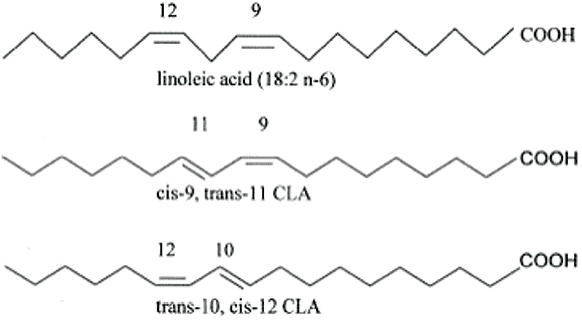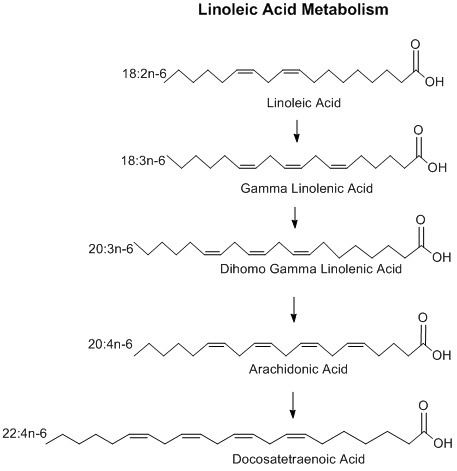Appearance Colorless oil Molar mass 280.4455 g/mol Boiling point 230 °C Soluble in Water | Formula C18H32O2 Melting point -5 °C Density 900 kg/m³ | |
 | ||
IUPAC ID cis, cis-9,12-Octadecadienoic acid | ||
Linoleic acid (LA) is a polyunsaturated omega-6 fatty acid. It is a colorless liquid at room temperature. In physiological literature, it has a lipid number of 18:2 cis,cis-9,12. Linoleic acid is a carboxylic acid with an 18-carbon chain and two cis double bonds; with the first double bond located at the sixth carbon from the methyl end.
Contents

Linoleic acid belongs to one of the two families of essential fatty acids, which means that the human body cannot synthesize it from other food components.

The word "linoleic" derived from the Greek word linon (flax). Oleic means "of, relating to, or derived from oil of olive" or "of or relating to oleic acid" because saturating the omega-6 double bond produces oleic acid.

Conjugated linoleic acid cla
In physiology

LA is a polyunsaturated fatty acid used in the biosynthesis of arachidonic acid (AA) and thus some prostaglandins, leukotrienes (LTA, LTB, LTC), and thromboxane (TXA). It is found in the lipids of cell membranes. It is abundant in many nuts, fatty seeds (flax seeds, hemp seeds, poppy seeds, sesame seeds, etc.) and their derived vegetable oils; comprising over half (by weight) of poppy seed, safflower, sunflower, corn, and soybean oils.
LA is converted by various lipoxygenases, cyclooxygenases, certain cytochrome P450 enzymes (the CYP monooxygenases), and non-enzymatic autooxidation mechanisms to mono-hydroxyl products viz., 13-Hydroxyoctadecadienoic acid and 9-Hydroxyoctadecadienoic acid; these two hydroxy metabolites are enzymatically oxidized to their keto metabolites, 13-oxo-octadecadienoic acid and 9-oxo-octadecdienoic acid. Certain cytochrome P450 enzymes, the CYP epoxygenases, metabolize LA to epoxide products viz., its 12,13-epoxide, Vernolic acid and its 9,10-epoxide, Coronaric acid. All of these LA products have bioactivity and are implicated in human physiology and pathology as indicated in the cited linkages.
Linoleic acid is an essential fatty acid that must be consumed for proper health. A diet only deficient in linoleate (the salt form of the acid) causes mild skin scaling, hair loss, and poor wound healing in rats.
Along with oleic acid, linoleic acid is released by cockroaches upon death which has the effect of preventing other roaches from entering the area. This is similar to the mechanism found in ants and bees, which also release oleic acid upon death.
The first step in the metabolism of LA is performed by Δ6desaturase, which converts LA into gamma-linolenic acid (GLA).
There is evidence suggesting that infants lack Δ6desaturase of their own, and must acquire it through breast milk. Studies show that breast-milk fed babies have higher concentrations of GLA than formula-fed babies, while formula-fed babies have elevated concentrations of LA.
GLA is converted to dihomo-gamma-linolenic acid (DGLA), which in turn is converted to arachidonic acid (AA). One of the possible fates of AA is to be transformed into a group of metabolites called eicosanoids during the inflammatory response and during physical activity; eicosanoids are a class of paracrine hormones. The three types of eicosanoids are prostaglandins, thromboxanes, and leukotrienes. Eicosanoids produced from AA tend to promote (not cause) inflammation and promote growth during and after physical activity in healthy humans. For example, both AA-derived thrombaxane and leukotrieneB4 are proaggregatory and vasoconstrictive eicosanoids during inflammation. The oxidized metabolic products of linoleic acid, such as 9-hydroxyoctadecanoic acid and 13-hydroxyoctadecanoic acid, have also been shown to activate TRPV1, the capsaicin receptor, and through this might play a major role in hyperalgesia and allodynia.
Threre are some suggested negative health effects related to this inflammation promoting function of linoleic acid as an omega-6 fatty acid.
Industrial uses
Linoleic acid is used in making quick-drying oils, which are useful in oil paints and varnishes. These applications exploit the easy reaction of the linoleic acid with oxygen in air, which leads to crosslinking and formation of a stable film called linoxyn.
Reduction of linoleic acid yields linoleyl alcohol. Linoleic acid is a surfactant with a critical micelle concentration of 1.5 x 10−4 M @ pH 7.5.
Linoleic acid has become increasingly popular in the beauty products industry because of its beneficial properties on the skin. Research points to linoleic acid's anti-inflammatory, acne reductive, and moisture retentive properties when applied topically on the skin.
Use in research
Linoleic acid lipid radicals can be used to show the antioxidant effect of natural phenols. Experiments on linoleic acid subjected to 2,2′-azobis (2-amidinopropane) dihydrochloride induced oxidation of linoleic acid; hence producing lipid radicals and then the use of different combinations of phenolics show that binary mixtures can lead to either a synergetic antioxidant effect or to an antagonistic effect towards the lipid radicals. Research like this is useful in discovering which phenols prevent the autoxidation of lipids in vegetable oils.
